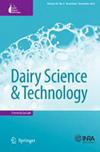Analysis of Dairy Cow Behavior during Milking Associated with Lameness
Q2 Agricultural and Biological Sciences
引用次数: 0
Abstract
The detection of lame cows is a challenging and time-consuming issue for dairy farmers. Many farmers use the milking time to monitor the condition of their animals. Because lame cows often show increased stepping when standing to relieve pressure on aching claws, we investigated whether lame cows showed increased activity in the milking parlor. On 20 Swiss dairy farms, 647 cows were scored on lameness with a five-point locomotion score and categorized as clinical lame and non-lame cows in order to see if there are differences in behavior between these two groups (non-lame = scores 1 and 2; lame = scores 3, 4, and 5). During one evening milking, the behavior of the cows was analyzed. A three-dimensional accelerometer, attached to the milking cluster, detected the hind leg activity indirectly via the movements of the milking unit. Additionally, head movements, as well as weight shifting and the number of steps with the front legs, were analyzed from video recordings. Owing to a high percentage of false positive hind leg activities in some milkings measured by the sensor, only 60% of the collected data were evaluated for behavior (356 cows/milkings on 17 farms). Twenty-seven percent of the investigated cows were classified as lame. The lameness prevalence was increasing with increasing parity. Lame cows showed a higher hind leg activity during milking as well as a higher frequency of front steps and weight shifting events during their stay in the milking parlor than non-lame cows. No relation between the status of lameness and the number of head movements could be seen. Observation of increased stepping and weight shifting of individual animals during milking by the farmer could be used as an additional indicator to detect lame cows, but further investigations are required.奶牛产奶过程中与跛行相关的行为分析
对奶农来说,检测跛牛是一个既具有挑战性又耗时的问题。许多农民利用挤奶时间来监测牲畜的状况。由于跛牛在站立以减轻疼痛爪子的压力时经常表现出增加的步伐,我们调查了跛牛在挤奶室是否表现出增加的活动。在瑞士的20个奶牛场中,647头奶牛用5分的运动得分对跛行进行评分,并将其分为临床跛行奶牛和非跛行奶牛,以观察这两组之间的行为是否存在差异(非跛行奶牛=得分1和2;lame =得分3,4,5)。在一个晚上挤奶时,对奶牛的行为进行了分析。一个三维加速度计,连接到挤奶集群,通过挤奶单元的运动间接检测后腿的活动。此外,研究人员还从录像中分析了头部运动、体重转移和前腿行走的步数。由于在传感器测量的一些挤奶中,后腿活动假阳性的比例很高,因此仅对收集到的60%的数据进行了行为评估(17个农场的356头奶牛/挤奶)。被调查的奶牛中有27%被归类为跛牛。跛行率随胎次增加而增加。与正常奶牛相比,跛足奶牛在挤奶时后腿活动量更高,在挤奶时前台阶和体重转移事件的频率更高。跛行状态与头部运动次数之间没有关系。农民在挤奶过程中观察到单头牛的步伐和体重变化增加,可作为检测跛牛的附加指标,但需要进一步调查。
本文章由计算机程序翻译,如有差异,请以英文原文为准。
求助全文
约1分钟内获得全文
求助全文
来源期刊

Dairy Science & Technology
农林科学-食品科技
CiteScore
2.30
自引率
0.00%
发文量
0
审稿时长
2 months
期刊介绍:
Information not localized
 求助内容:
求助内容: 应助结果提醒方式:
应助结果提醒方式:


